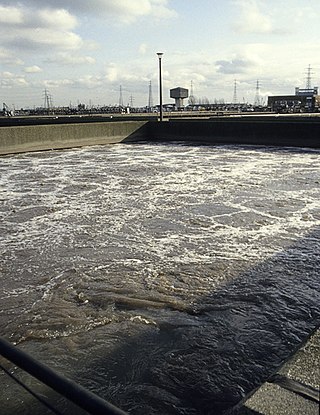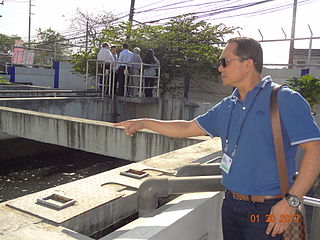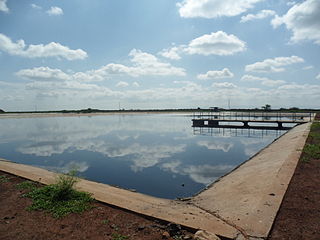This article needs additional citations for verification .(April 2013) |
Coarse bubble diffusers are a pollution control technology used to aerate and or mix wastewater for sewage treatment.
This article needs additional citations for verification .(April 2013) |
Coarse bubble diffusers are a pollution control technology used to aerate and or mix wastewater for sewage treatment.
Coarse bubble diffusers produce 1/4 to 1/2 inch (6.4 to 13 mm) bubbles which rise rapidly from the floor of a wastewater treatment plant or sewage treatment plant tank. They are typically used in grit chambers, equalization basins, chlorine contact tanks, and aerobic digesters, and sometimes also in aeration tanks. Generally they are better at vertically "pumping" water than at mass transfer of oxygen. Coarse bubble diffusers typically provide half the mass transfer of oxygen as compared to fine bubble diffusers, given the same air volume.[ citation needed ]
Often in non-Newtonian or pseudoplastic fluids, such as a digester with high solids concentration, it does make sense to use coarse bubble diffusers rather than fine bubble diffusers, due to the larger bubbles' ability to shear through more viscous wastewater.[ citation needed ]
However, over the past two decades, coarse bubble diffusers have been used less frequently, primarily due to the ever increasing cost of energy and the availability of more reliable, highly efficient fine bubble diffusers. [1] Manufacturers of diffused aeration systems claim that converting from coarse bubble to fine bubble system should yield a 50 percent energy cost savings. [2] Specifically, in aeration tanks, a system that utilizes coarse bubble diffusers requires 30 to 40 percent more process air than a fine bubble diffused air system to provide the same level of treatment. [3] The exception would be in secondary treatment (or side processing) phases. In these processing tanks, floc particles, sediment and carbonate buildup tend to plug or clog the small air release openings on the fine bubble diffusers. Because of their small air openings, fine bubble diffusers cease to have an advantage. Currently, coarse bubble diffusers are the mainstay solution.
These diffusers are typically made in the shape of a perforated rectangular pipe called a wide band, or a cap of 3 inches (76 mm) in diameter with an elastomeric membrane. Other varieties of coarse bubble diffusers exist, though it is generally accepted that all of them perform similarly with respect to mass oxygen transfer. When comparing disc-shaped diffusers, the majority fail to withstand specific challenges, [4] beyond 1 or 2 years, which include: clogging, blowing off and cracking. Any coarse bubble diffuser that eliminates these problems would deliver a huge cost-savings, not only in product replacement, but in system downtime to facilitate their exchange. This is a motivating factor considered by budget-sensitive operators at municipal waste water treatment processing plants.

A septic tank is an underground chamber made of concrete, fiberglass, or plastic through which domestic wastewater (sewage) flows for basic sewage treatment. Settling and anaerobic digestion processes reduce solids and organics, but the treatment efficiency is only moderate. Septic tank systems are a type of simple onsite sewage facility. They can be used in areas that are not connected to a sewerage system, such as rural areas. The treated liquid effluent is commonly disposed in a septic drain field, which provides further treatment. Nonetheless, groundwater pollution may occur and can be a problem.

The activated sludgeprocess is a type of biological wastewater treatment process for treating sewage or industrial wastewaters using aeration and a biological floc composed of bacteria and protozoa. It uses air and microorganisms to biologically oxidize organic pollutants, producing a waste sludge containing the oxidized material.

Industrial wastewater treatment describes the processes used for treating wastewater that is produced by industries as an undesirable by-product. After treatment, the treated industrial wastewater may be reused or released to a sanitary sewer or to a surface water in the environment. Some industrial facilities generate wastewater that can be treated in sewage treatment plants. Most industrial processes, such as petroleum refineries, chemical and petrochemical plants have their own specialized facilities to treat their wastewaters so that the pollutant concentrations in the treated wastewater comply with the regulations regarding disposal of wastewaters into sewers or into rivers, lakes or oceans. This applies to industries that generate wastewater with high concentrations of organic matter, toxic pollutants or nutrients such as ammonia. Some industries install a pre-treatment system to remove some pollutants, and then discharge the partially treated wastewater to the municipal sewer system.
An aerated lagoon is a simple wastewater treatment system consisting of a pond with artificial aeration to promote the biological oxidation of wastewaters.
Onsite sewage facilities (OSSF), also called septic systems, are wastewater systems designed to treat and dispose of effluent on the same property that produces the wastewater, in areas not served by public sewage infrastructure.

Water aeration is the process of increasing or maintaining the oxygen saturation of water in both natural and artificial environments. Aeration techniques are commonly used in pond, lake, and reservoir management to address low oxygen levels or algal blooms.
Aeration is the process by which air is circulated through, mixed with or dissolved in a liquid or other substances that act as a fluid. Aeration processes create additional surface area in the mixture, allowing greater chemical or suspension reactions.

Secondary treatment is the removal of biodegradable organic matter from sewage or similar kinds of wastewater. The aim is to achieve a certain degree of effluent quality in a sewage treatment plant suitable for the intended disposal or reuse option. A "primary treatment" step often precedes secondary treatment, whereby physical phase separation is used to remove settleable solids. During secondary treatment, biological processes are used to remove dissolved and suspended organic matter measured as biochemical oxygen demand (BOD). These processes are performed by microorganisms in a managed aerobic or anaerobic process depending on the treatment technology. Bacteria and protozoa consume biodegradable soluble organic contaminants while reproducing to form cells of biological solids. Secondary treatment is widely used in sewage treatment and is also applicable to many agricultural and industrial wastewaters.

Sequencing batch reactors (SBR) or sequential batch reactors are a type of activated sludge process for the treatment of wastewater. SBR reactors treat wastewater such as sewage or output from anaerobic digesters or mechanical biological treatment facilities in batches. Oxygen is bubbled through the mixture of wastewater and activated sludge to reduce the organic matter. The treated effluent may be suitable for discharge to surface waters or possibly for use on land.

Sewage sludge treatment describes the processes used to manage and dispose of sewage sludge produced during sewage treatment. Sludge treatment is focused on reducing sludge weight and volume to reduce transportation and disposal costs, and on reducing potential health risks of disposal options. Water removal is the primary means of weight and volume reduction, while pathogen destruction is frequently accomplished through heating during thermophilic digestion, composting, or incineration. The choice of a sludge treatment method depends on the volume of sludge generated, and comparison of treatment costs required for available disposal options. Air-drying and composting may be attractive to rural communities, while limited land availability may make aerobic digestion and mechanical dewatering preferable for cities, and economies of scale may encourage energy recovery alternatives in metropolitan areas.
An aerobic treatment system (ATS), often called an aerobic septic system, is a small scale sewage treatment system similar to a septic tank system, but which uses an aerobic process for digestion rather than just the anaerobic process used in septic systems. These systems are commonly found in rural areas where public sewers are not available, and may be used for a single residence or for a small group of homes.
An air diffuser or membrane diffuser is an aeration device typically in the shape of a disc, tube or plate, which is used to transfer air and with that oxygen into the sewage or industrial wastewater. Oxygen is required by microorganisms/bacteria residents in the water to break down the pollutants. Diffusers use either rubber membranes or ceramic elements typically and produce either fine or coarse bubbles.

Fine bubble diffusers are a pollution control technology used to aerate wastewater for sewage treatment.

Aeration turbines are designed to aerate and mix fluids industrially. They are foremost used in brewing, pond aeration and sewage treatment plants.
Aerobic digestion is a process in sewage treatment designed to reduce the volume of sewage sludge and make it suitable for subsequent use. More recently, technology has been developed that allows the treatment and reduction of other organic waste, such as food, cardboard and horticultural waste. It is a bacterial process occurring in the presence of oxygen. Bacteria rapidly consume organic matter and convert it into carbon dioxide, water and a range of lower molecular weight organic compounds. As there is no new supply of organic material from sewage, the activated sludge biota begin to die and are used as food by saprotrophic bacteria. This stage of the process is known as endogenous respiration and it is process that reduces the solid concentration in the sludge.

Sewage treatment is a type of wastewater treatment which aims to remove contaminants from sewage to produce an effluent that is suitable to discharge to the surrounding environment or an intended reuse application, thereby preventing water pollution from raw sewage discharges. Sewage contains wastewater from households and businesses and possibly pre-treated industrial wastewater. There are a high number of sewage treatment processes to choose from. These can range from decentralized systems to large centralized systems involving a network of pipes and pump stations which convey the sewage to a treatment plant. For cities that have a combined sewer, the sewers will also carry urban runoff (stormwater) to the sewage treatment plant. Sewage treatment often involves two main stages, called primary and secondary treatment, while advanced treatment also incorporates a tertiary treatment stage with polishing processes and nutrient removal. Secondary treatment can reduce organic matter from sewage, using aerobic or anaerobic biological processes.
Membrane bioreactors are combinations of some membrane processes like microfiltration or ultrafiltration with a biological wastewater treatment process, the activated sludge process. These technologies are now widely used for municipal and industrial wastewater treatment. The two basic membrane bioreactor configurations are the submerged membrane bioreactor and the side stream membrane bioreactor. In the submerged configuration, the membrane is located inside the biological reactor and submerged in the wastewater, while in a side stream membrane bioreactor, the membrane is located outside the reactor as an additional step after biological treatment.

Jet aerators are applied across a wide range of water, wastewater and biosolids treatment applications. Their primary purpose is to transfer oxygen to the liquid or sludge. A Jet aerator works through aspirating technology by simultaneously introducing large volumes of high kinetic energy liquid and air through one or more jet nozzles. The high velocity liquid exits the inner, primary jet and rapidly mixes with the incoming air in the outer jet. This intense mixing and high degree of turbulence in the gas/liquid cloud travels outward from the jet along the basin floor prior to the vertical rise of the gas bubble column to the liquid surface.

Facultative lagoons are a type of waste stabilization pond used for biological treatment of industrial and domestic wastewater. Sewage or organic waste from food or fiber processing may be catabolized in a system of constructed ponds where adequate space is available to provide an average waste retention time exceeding a month. A series of ponds prevents mixing of untreated waste with treated wastewater and allows better control of waste residence time for uniform treatment efficiency.
{{cite web}}: CS1 maint: archived copy as title (link){{cite web}}: CS1 maint: archived copy as title (link)